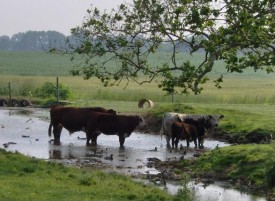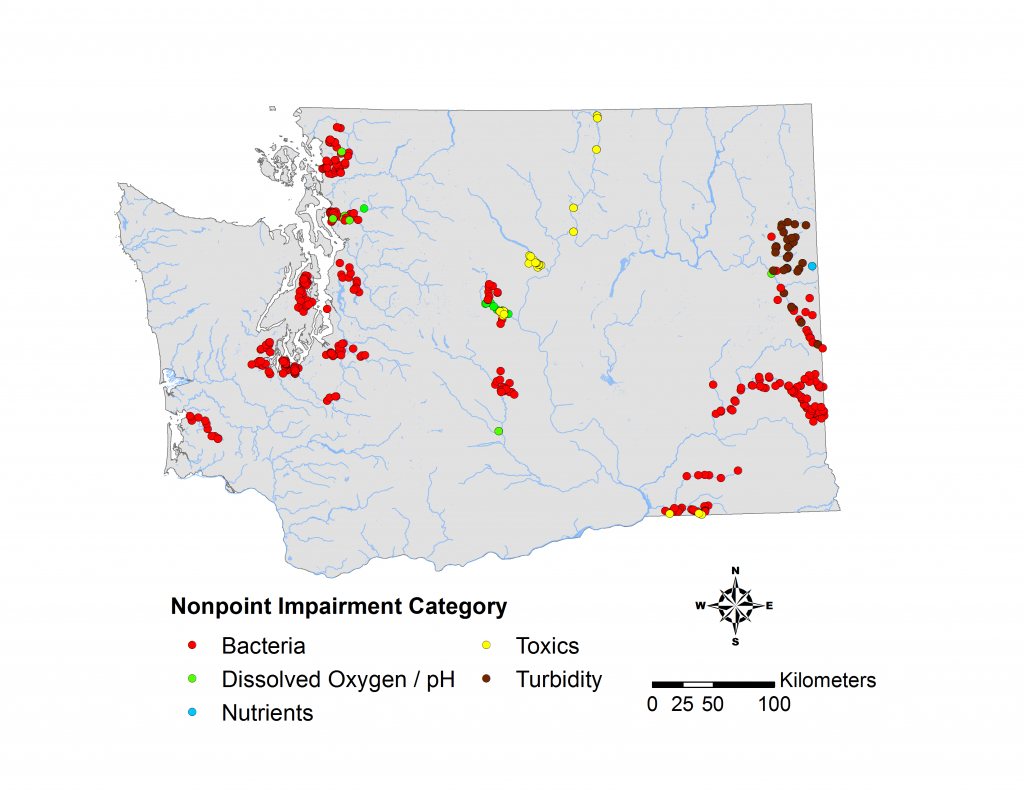By Paul Pickett and Siana Wong, Washington State Department of Ecology

Improper management of livestock and manure can lead to bacterial contamination.
All of us who care about lakes know that the release of bacteria, nutrients, sediments, or oil to the watershed surrounding a lake can harm public health, the lake’s ecosystem, and the beauty of the lake. While “point sources” of pollution like industrial and municipal wastewater treatment plants and urban stormwater are regulated by Ecology through the National Pollutant Discharge Elimination System, “nonpoint sources,” present in most lake watersheds, also contribute significantly to water quality problems around the state.
Nonpoint sources (NPS) tend to be diffuse inputs like rural stormwater runoff, direct discharges, ground water contamination, or shoreline modification. EPA requires Ecology to write a “Nonpoint Plan” to guide its efforts to control NPS pollution under the Clean Water Act and Coastal Zone Act Reauthorization Amendments.
Gathering NPS information in one place
To establish a foundation for Ecology’s current revision of its Nonpoint Plan, WALPA Board member and Ecology scientist Siana Wong, with the support of Ecology environmental engineer Paul Pickett, did a statewide assessment of existing information on NPS pollution. It is available on Ecology’s website (https://fortress.wa.gov/ecy/publications/SummaryPages/1403028.html).
This study explored several kinds of information available about NPS pollution:
- EPA guidance on monitoring controlling NPS pollution
- Recently published literature relevant to Washington State
- The calculated NPS load reduction targets from 49 Water Quality Improvement (Total Maximum Daily Load [TMDL]) studies in Washington since 2005
- An exploratory analysis of TMDL allocations and land uses using GIS
- An evaluation of grants using EPA Section 319 funds for NPS control; and
- Four case studies in data-rich watersheds: Walla Walla River, Lower Yakima River, Dungeness River and Bay, and Samish Bay.
Siana and Paul synthesized this information to characterize the nature and extent of NPS pollution in different regions of Washington, and to draw conclusions about how different land use activities can contribute to NPS pollution.
What constitutes NPS pollution?
One component of NPS pollution is bacterial contamination, a widespread problem that can come from a variety of sources, including improper management of livestock and manure, septic systems, pets, and birds and wildlife. More typically a problem in the rainy season, bacterial contamination can also occur in the summer. Agricultural activities, if not carefully managed, can contribute to nutrient and pesticide pollution, sediment erosion, and loss of shoreline plants. Urban development can contaminate stormwater runoff, sending bacteria, nutrients, toxic chemicals, and sediment into lakes, streams and Puget Sound.
A common problem is damage to shoreline areas from erosion, bulkheads and channelization, loss of natural woody debris, removal of plants, and loss of off-channel habitat. Although not exactly “pollution,” EPA considers this to be a nonpoint source, since it hurts aquatic ecosystems through loss of complexity, increased erosion, and by allowing pollutants from upland areas to run off more easily into lakes and streams.
NPS pollution can also impact ground water, and harm lakes and streams indirectly through inflows of contaminated ground water. Prime examples of this are the high nitrate levels found in some agricultural areas.
While we know that NPS pollution is a problem, this report pulls together scientific information into a single document to illustrate its scope in Washington. While much has been done to clean up NPS pollution, there is still widespread contamination that needs our attention to keep lakes and other waterbodies healthy.
To learn more about Ecology’s process to update its Nonpoint Plan, contact Ben Rau at 360-407-6551 or ben.rau@ecy.wa.gov.










